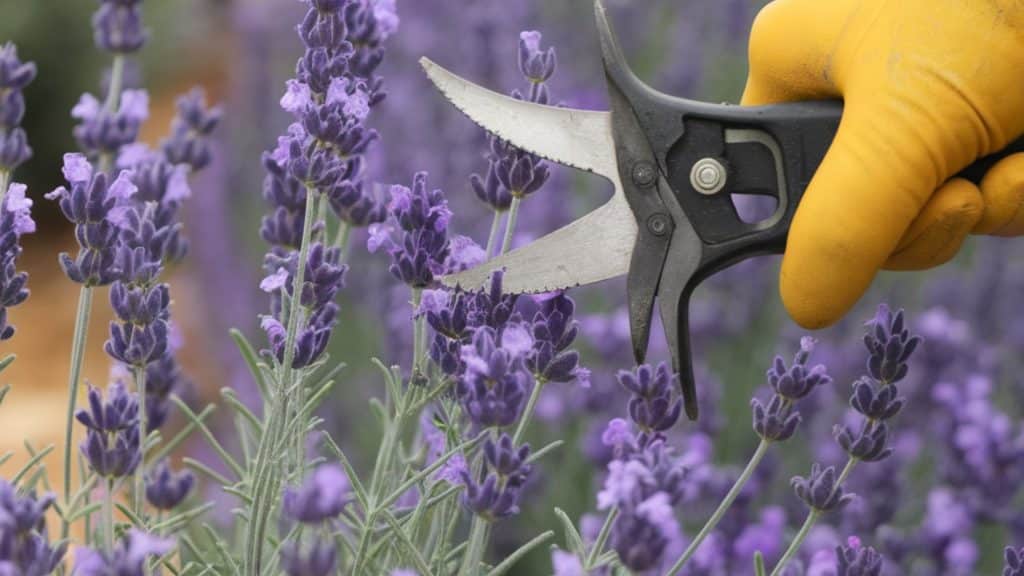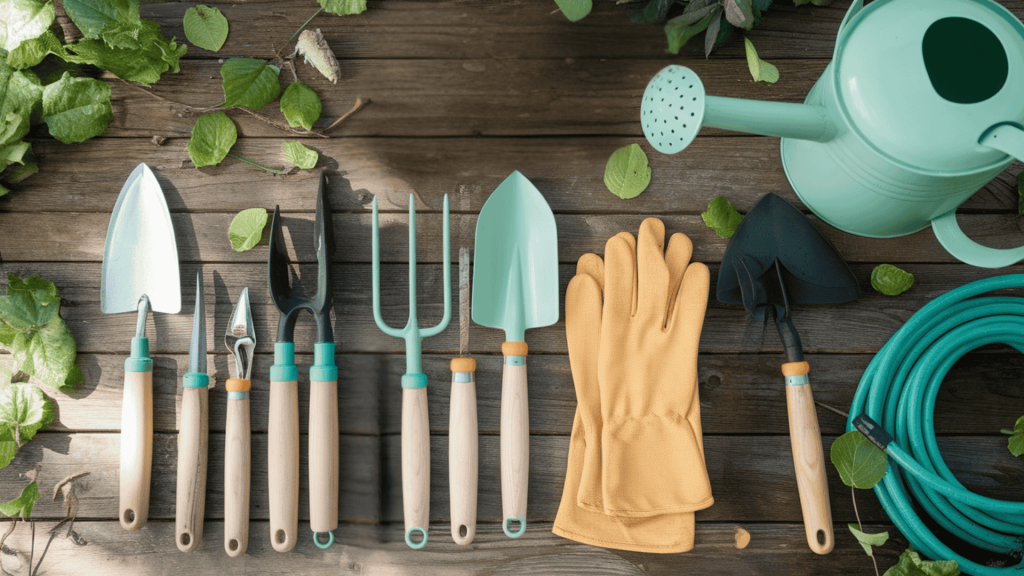Watching your beautiful lavender plants turn into woody, sparse shrubs with fewer fragrant blooms each year?
Most gardeners unknowingly harm their lavender by pruning at the wrong time or cutting too aggressively, leading to stressed plants that struggle to recover.
What if you could master the simple techniques that keep lavender plants compact, healthy, and bursting with aromatic flowers season after season?
Proper pruning changes scraggly lavender into the lush, fragrant garden centerpiece you’ve always wanted.
We’ll walk you through the exact timing, tools, and techniques professional gardeners use to prune lavender correctly.
From understanding your plant’s growth cycle to making the perfect cuts, you’ll discover everything needed to keep your lavender thriving for years to come.
Ready to give your lavender the care it deserves? Let’s dive into the step-by-step process.
Understanding Lavender Growth Cycles
Lavender follows a predictable growth pattern that changes with the seasons. This herb starts its active growth in spring when temperatures warm up, with new shoots appearing from the base.
During summer, lavender reaches its peak bloom period, focusing energy on producing flowers and essential oils. Fall brings a slowdown period where growth stops and the plant prepares for winter rest.
Lavender enters dormancy during cold months, conserving energy in its root system.
The complete cycle takes about 12 months, with young plants needing 2-3 years to fully establish. Once mature, lavender can bloom for 15-20 years with proper care.
Comprehending these phases helps you choose the perfect moment to prune your lavender plants.
Key Growth Cycle Points
- Spring Growth Phase: Active growth begins when temperatures warm up, and new shoots appear from the base
- Summer Peak Bloom: The Plant focuses energy on flower and essential oil production during this period
- Fall Preparation: Growth stops as the plant prepares for winter dormancy and conserves energy
- Plant Lifespan: Young plants need 2-3 years to establish, mature plants bloom for 15-20 years
Optimal Period for Pruning Lavender
Comprehending these growth phases helps you choose the perfect moment to prune your lavender plants. Getting the timing right means healthier plants and better blooms year after year.
Best Time to Prune Lavender
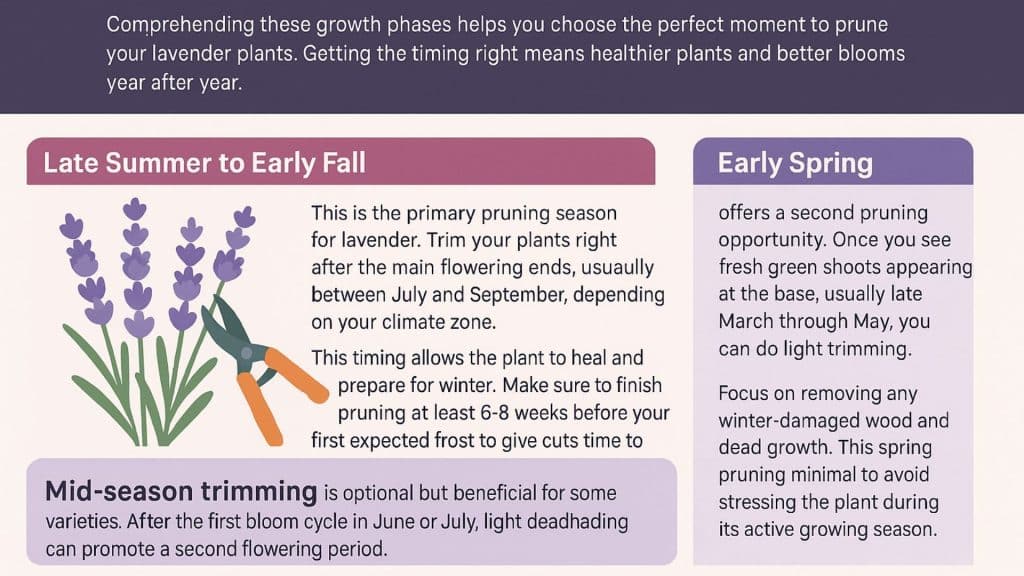
This involves removing spent flower stalks without cutting into the woody stems. Keep this trimming minimal to avoid stressing the plant during its active growing season.
How to Prune Lavender: Step-by-Step Guide
Once you know when to prune, the next step is learning how to do it properly. These seven simple steps will help you trim your lavender like a pro, even if you’re a beginner.
Tools Required
- Get sharp pruning shears or garden scissors
- Wipe blades with rubbing alcohol
- Check blade sharpness before starting
- Avoid using dull tools
- Replace or sharpen damaged tools
- Keep tools clean throughout pruning
- Test cut on a small stem first
- Have backup tools ready
Step 1: Choose the Right Day
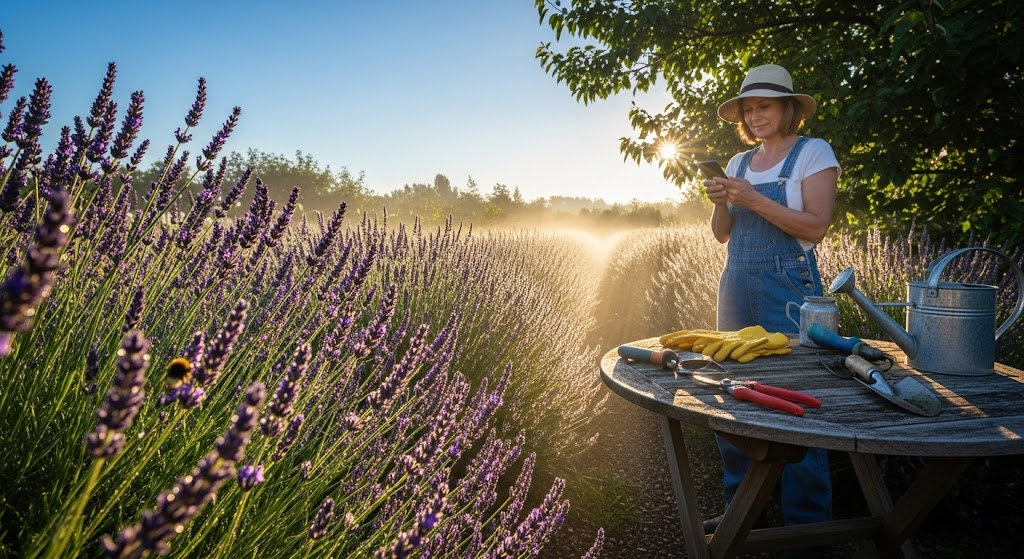
Pick a dry, sunny morning for pruning. Wet conditions spread plant diseases easily.
Check the weather forecast and avoid rainy days. Morning hours give cuts time to dry before evening moisture arrives. Your lavender will thank you for this timing.
Step 2: Remove Dead Flowers First
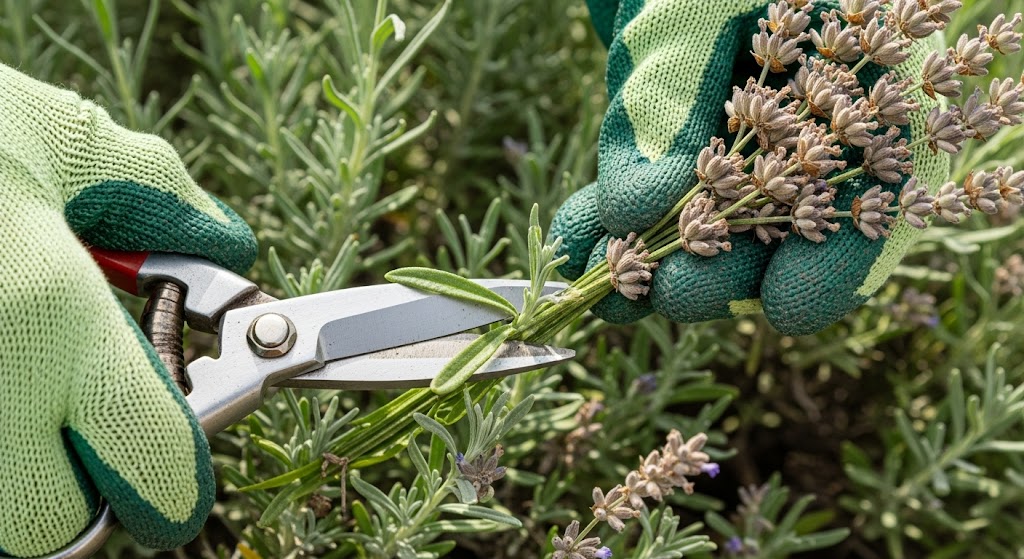
Start by cutting off all spent flower spikes. Cut just above the first set of leaves below each flower stem.
This step is called deadheading. It stops the plant from making seeds and puts energy back into growing healthy foliage instead.
Step 3: Cut Back One-Third of Growth
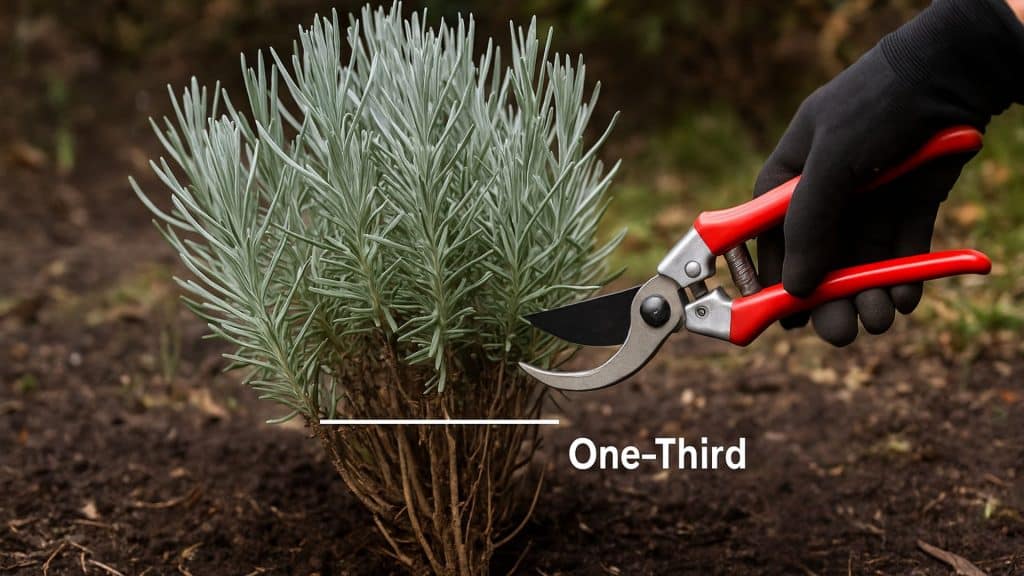
Trim about one-third of the plant’s height, but never cut into old woody stems at the bottom.
Look for green growth and cut just above it. The woody base doesn’t grow new shoots, so cutting there can kill your plant permanently.
Step 4: Shape the Plant
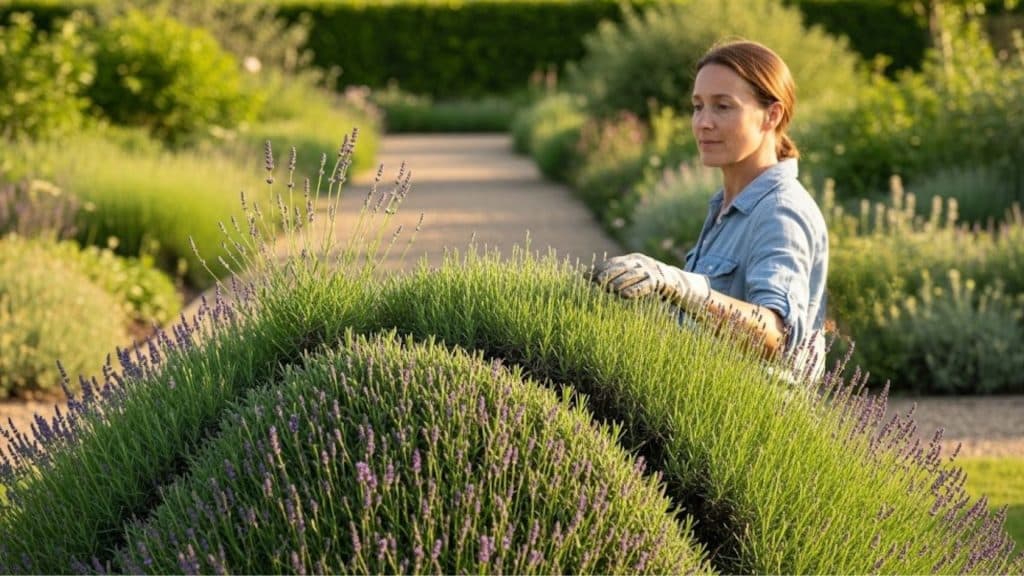
Create a rounded, mounded shape by cutting stems at different heights. This prevents your lavender from looking flat on top.
Work your way around the plant, stepping back often to check your progress. Aim for a natural, flowing appearance.
Step 5: Clean Up Debris
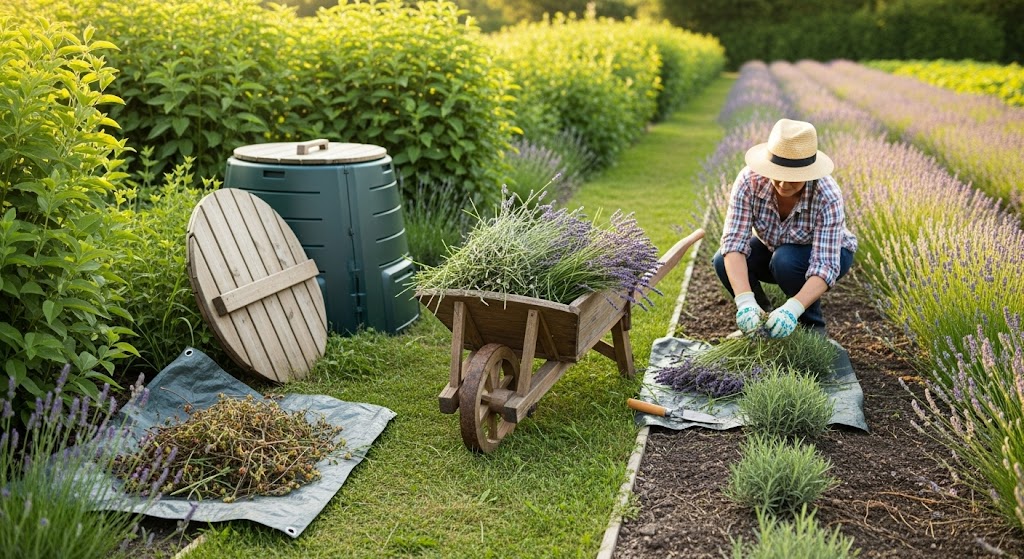
Remove all cut stems and leaves from around the plant base. Old plant material can harbor pests and diseases over winter.
Put healthy trimmings in your compost pile, but throw away any diseased or moldy pieces in the regular trash.
Step 6: Water Lightly
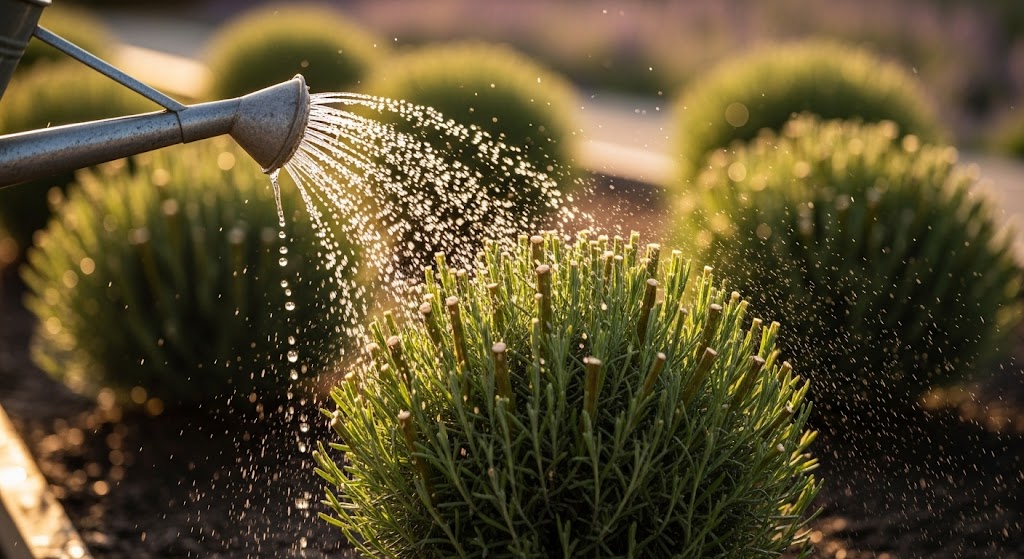
Give your freshly pruned lavender a gentle drink, but don’t soak it. Too much water after pruning can cause root rot.
Just enough moisture helps the plant recover from the stress of cutting. Let the soil dry between waterings as usual.
Following these steps keeps your lavender healthy and blooming strong. Take your time with each cut, and your plants will thank you with better growth next season.
Different lavender types may need slightly different care, so let’s examine those next.
Special Considerations for Lavender Varieties
Not all lavender plants are the same when it comes to pruning. Different varieties need different care, so knowing your lavender type helps you prune it correctly.
| Lavender Type | Pruning Timing | Cutting Amount | Special Notes |
|---|---|---|---|
| English Lavender | Late summer after bloom | Cut back 1/3 of the plant | Most cold-hardy type. Can handle heavier pruning than other varieties. |
| French Lavender | Light pruning year-round | Remove spent flowers only | Tender variety. Avoid heavy cutting in cold climates. Prune gently. |
| Spanish Lavender | After each bloom cycle | Deadhead regularly | Blooms multiple times per season. Light, frequent pruning works best. |
| Woolly Lavender | Minimal pruning needed | Light shaping only | Slow-growing variety. Over-pruning can damage or kill the plant. |
| Hidcote Lavender | Traditional timing works | Standard 1/3 reduction | Compact English type. Responds well to a regular annual pruning schedule. |
| Munstead Lavender | Early spring or fall | Moderate cutting back | Hardy English variety. It can take spring or fall pruning equally well. |
Knowing your lavender variety takes the guesswork out of pruning. When you match your technique to your plant type, you’ll get better results and healthier plants. Even with the right variety knowledge, there are still some common mistakes to watch out for.
Common Pruning Mistakes to Avoid
Even experienced gardeners can make pruning errors that hurt their lavender plants. Learning what not to do is just as important as knowing the right techniques.
- Cutting Into Woody Stems: Never prune below the green growth into old, brown woody parts. These areas won’t regrow and can kill your plant.
- Pruning Too Late in Fall: Avoid cutting lavender within 6 weeks of first frost. Late pruning leaves plants vulnerable to winter damage and death.
- Over-Pruning Young Plants: Don’t heavily prune lavender in its first year. Young plants need time to establish strong root systems before major cutting.
- Using Dull or Dirty Tools: Blunt shears crush stems instead of cutting cleanly. Dirty tools spread diseases between plants. Always clean and sharpen first.
- Pruning When Wet: Never cut lavender during rain or when dew covers the plant. Wet conditions help bacteria and fungi enter fresh cuts.
- Removing Too Much at Once: Taking more than one-third of the plant causes shock. Stressed lavender may stop blooming or die completely.
- Ignoring Plant Shape: Random cutting results in uneven, unattractive plants. Always step back and check your work as you prune around the plant.
Avoiding these common mistakes will keep your lavender plants healthy and productive for years to come. Remember, it’s better to prune less than to cut too much and damage your plant.
Conclusion
Mastering lavender pruning changes struggling plants into thriving, aromatic garden stars.
Remember the golden rules: prune during dry conditions, never cut into woody stems, and remove only one-third of the plant’s height.
Match your timing to your specific lavender variety for the best results. Why does this matter?
Properly pruned lavender doesn’t just survive, it flourishes with abundant blooms, compact growth, and that heavenly fragrance we all love.
Ready to put these skills into practice?
Grab your clean, sharp pruning shears and head to your garden. Your lavender plants are waiting for the care they deserve.
Have questions about your specific variety or encountered any pruning challenges? Share your experiences in the comments below. We’d love to help you succeed!
Check out more posts on plant care and growing tips.

